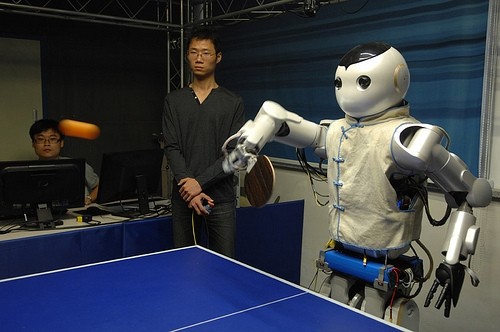
HANGZHOU, Oct. 10 (Xinhua) -- The skills of China's table tennis players are virtually unmatched. However, they may soon face competition in the form of two humanoid robots that have been programmed to serve, return and score.
The robots made their debut on Sunday at east China's Zhejiang University, where they played games of table tennis with each other and with human players.
"Wu" and "Kong" are 1.6 meters tall and weigh 55 kg each. Decked out in old-fashioned Chinese jackets, they have arms, legs, eyes, ears and hair, just like their human counterparts.
The robots track tennis table balls using eye-mounted cameras, predicting the movement of the balls and responding accordingly.
Human players rely on experience and intuition to track the balls and return them to their opponents. The robots, on the other hand, use a complicated identification and positioning system to perform, according to Xiong Rong, chief designer at the university's robot lab.
The cameras capture 120 images per second, transmitting the images to the robots' processors and allowing them to respond appropriately after calculating the ball's position, speed, angle, landing position and path, according to Xiong.
It takes just 50 to 100 milliseconds for the robots to respond, Xiong said. Their ability to predict the ball's landing position is quite accurate, with a margin of error of just 2.5 cm, Xiong added.
"We tried to develop a robot that is capable of accurate control and instant, continuous response," Xiong said.
The robots derive their names from Sun Wukong, or "Monkey King," a central character in the epic Chinese novel "Journey to the West." In the novel, Sun Wukong is a symbol of agility and intelligence.
"Table tennis creates higher requirements for the robots in terms of reaction time, visual processing, identification and calculation," Xiong said.
Humanoid robots have become a global trend in robot design and development, with countries such as Japan, the United States and France working to create robots that resemble humans.
Japanese scientists have already designed "waiter robots" that can serve food and drinks, and interactive robots that can catch baseballs are under development, according to Xiong.
The robot program of Zhejiang University is part of the nation's State High-Tech Development Plan, a program designed by the Ministry of Science and Technology to stimulate the development of advanced technology in a wide range of fields such as biotechnology, information technology and automation.
Scientists at Zhejiang University have spent four years on the development of Wu and Kong, who represent a third generation of robots that are more capable than their predecessors, Xiong said.
The robots feature "Ethernet for Plant Automation," a Chinese industrial automation protocol that enables them to react faster.
"Sometimes you'll find that these two robots can act beyond your wildest imagination," said designer Zhu Qiuguo.
Not only can the robots play table tennis between themselves, but can also play against human opponents.
"The record is 144 rounds between a robot and a human," said designer Zhang Yifeng.
However, the robots are yet not able to use complicated techniques like curving, shanking or slicing, Zhang said.
"We will improve their ability to move faster and more accurately control the ball while serving and returning in the future," Xiong said.
However, playing table tennis is not the ultimate goal of the project. Instead, it is simply a way to demonstrate the possibilities of robotic technology, Xiong added.
"We hope to deepen and expand our research so that the robots can someday function in aiding our daily lives," Xiong said.



 留言列表
留言列表